| |
July 2013
|

Harris
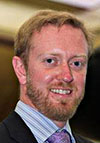 Tweddle Tweddle
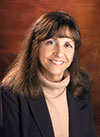 Leveson Leveson
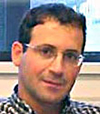 Modiano Modiano
 Williams Williams
 Hastings Hastings
 Young Young
|

1. Newsbriefs
AeroAstro welcomes Professor Wes Harris back to Building 33 and full-time faculty ranks. Wes was AeroAstro head from 2003 through 2008. In 2008, he accepted the Institute senior administrative role of associate provost for faculty equity. We also welcome back administrative assistant Peggy Edwards from her terrific service for Wes while he was associate provost. Wes is settled in 33-217 and Peggy in 33-322b.
Grad student Justin Kaderka has won best student paper award at the 19th International Academy of Astronautics Humans in Space Symposium in Cologne. Paper title: "Spacecraft failure detection by experienced pilots in a motion simulator."
AeroAstro doctoral candidate Brent E. Tweddle, who helped develop the VERTIGO optical system for our SPHERES robotic spacecraft used on the International Space Station, yesterday received the 2013 Boeing Engineering Student of the Year award from Boeing and Flightglobal at the Paris Air Show.
Prof. Nancy Leveson gave the keynote address at STAMP Workshop Europe 2013 organized by the University of Stuttgart and the Technical University of Braunschweig. STAMP is Leveson's accident causality model and the subject of her new book, "Engineering a Safer World." She also presented they keynote address, "Applying Systems Thinking to Safety in Aviation Psychology" at the I7th International Symposium on Aviation Psychology in Dayton.
Professor Eytan Modiano and his former student/LIDS alumn Krishna Jagannathan (Indian Institute of Technology Madras, India) were among the authors to receive Best Paper Award at the 12th International Symposium on Modeling and Optimization in Mobile, Ad Hoc, and Wireless Networks. Co-authors of the paper "Scheduling Strategies to Mitigate the Impact of Bursty Traffic in Wireless Networks" were Libin Jiang (Qualcomm, USA) and Palthya Lakshma Naik (IIT Madras, Chennai, India).
The International Association for the Advancement of Artificial intelligence has inducted Professor Brian Williams to its executive council.
NASA has selected AeroAstro alumn Tyler "Nick" Hague (SM '00) for the 2013 astronaut candidate class. He'll begin training at Johnson Space Center in August.
Professor Daniel Hastings, who last month completed a seven-and-a-half-year tenure as MIT’s dean of undergraduate education, has been appointed to a three-year term as director of the Singapore-MIT Alliance for Research and Technology (SMART), effective Jan. 1, 2014. - more-
NASA has chosen AeroAstro grad students Raquel Galvan, Mark Chodas, Ryan Kingsbury, and Sam Schreiner for its 2013 class of Space Technology Research Fellows. They'll conduct research relevant to NASA technology challenges aligned with NASA's space technology roadmaps, while pursuing their MIT degrees.
Congratulations to Professor Larry Young and his team in the Man Vehicle Lab: the National Space Biomedical Research Institute has announced funding of their proposed research project: “Countermeasures to Reduce Sensorimotor Impairment and Space Motion Sickness Resulting from Altered Gravity Levels.”
AeroAstroers took first place in a student poster contest at the AIAA's recent 43rd International Conference on Environmental Systems. Winners were Andrew Owens, Margaret Shaw, Ioana Josan-Drinceanu, Sydney Do and Olivier de Weck for the poster "HabNet: A Generalized Habitat Modeling Environment," and Sydney Do and Olivier de Weck for "An OPM-Based Grammar for Encoding and Synthesizing Life Support System Architectures within HabNet." The conference focuses on such topics as environmental control and life support systems, EVA, and thermal analysis.
More than 8,000 people from around the world have signed up for our MITx online version of 16.101X "Introduction to Aerodynamics," reports Professor Dave Darmofal. There's a new video about the course at http://bit.ly/17iOGRQ. |
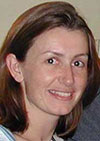
Willcox
|

2. New lab to study modeling, sim math challenges
A team co-led by MIT Aeronautics and Astronautics Department Professor Karen Willcox has been awarded a $12.5-million grant by the Department of Energy to create the multi-institutional DiaMonD Center. Funded under DoE’s Advanced Scientific Computing Research program, the center will address applied mathematics challenges in modeling and simulation for complex problems, with a focus on research at the interfaces of “data, models, and decision-making” (deriving its name from these three terms). -more- |
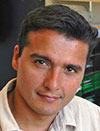
Lozano
|

3. Lozano named SPL head
Professor Paulo Lozano, newly promoted to the rank of Associate Professor with Tenure, is the Space Propulsion Laboratory's new director. Making the announcement, Professor Manuel Martinez-Sanchez wrote: "Over the past two decades, I have directed the SPL, which became a real hardware laboratory about 15 years ago when we installed our first vacuum chamber with the help of Paulo, then a MS candidate. As he began his PhD program in this laboratory, it became quickly evident that it was Paulo who truly understood and handled the accumulating instrumentation, and in the last few years, he and his students have added enormously to our experimental capabilities and to our portfolio of ideas and concepts. It is therefore my pleasure to take this opportunity to pass the SPL director's baton to Paulo, in the full confidence that the future of the laboratory is thereby assured for a long time to come." |
| |

4. Decavitator pays a visit
Decavitator, the hydrofoil in which, 22 years ago, Professor Mark Drela set the world speed record (18.5 knots, 21 mph) for a human-powered vessel, is paying us a visit. It's been returned to AeroAstro by the Boston Museum of Science where was on display for many years and is temporarily residing in the Neumann Hangar under the supersonic wind tunnel. You can see videos of the record run at http://bit.ly/165kuHy

|
| |

5. DBF Team places in competition
Libby Jones fills us in on the results of this year's AIAA Design-Build-Fly competition:
"At the DBF competition in Tucson, AZ, the MIT team came in fourth place out of about 50 teams. Our plane performed exactly as we designed it to, and we're really pleased with the results.
"Mission 1 was a speed mission in which the plane did as many laps as it could in 4 minutes with no payload, Mission 2 required us to carry as many 1/4 lb. model rockets inside the plane as possible (we carried 12, the most at the competition), and Mission 3 required us to carry model rockets internally and externally in one of six possible configurations. All missions required that the plane take off within a 30 ft. x 30 ft. box, making the longest possible takeoff roll 42 ft. on the diagonal.
"Tech inspection and our first and second missions went smoothly on Friday. Saturday we attempted our third mission around noon, but as soon as we set our plane down on the runway for takeoff, the wind dropped to zero and our takeoff roll ran long by one or two feet. The winds picked up in the afternoon, so we tried Mission 3 again in a 6 mph headwind, got off the ground within the box, and successfully completed the mission. Sunday we got to sit back and watch some glorious crashes. Everyone had a great time at the competition."
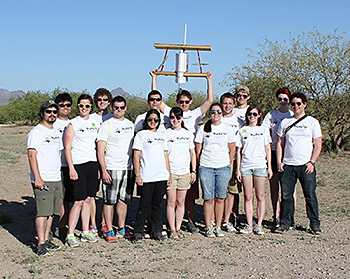 The team's plane, "Li'l Nugget" now hangs in the Neumann Hangar The team's plane, "Li'l Nugget" now hangs in the Neumann Hangar
|
| |

6. Department awards presented
At a May 29 luncheon, staff and faculty were honored with annual department awards. Recipients were:
Vickie Kerrebrock Award: To recognize students, staff, faculty or others, either individually or as members of a group, who have made significant contributions to building a sense of community in the Department of Aeronautics and Astronautics at MIT. Professor Manuel Martinez-Sanchez
Wings Award: To recognize an individual support staff member in AeroAstro for excellence. Sophia Hasenfus
Spirit of XVI Individual or team: Aeronautics and Astronautics staff whose work, commitment and enthusiasm contribute significantly to the achievement of the department mission. Individual: Jennifer Craig; Team: Fiscal Officers Ping Lee, Jori Barabino, Suxin Hu, Jenny Leith
AIAA Teaching Award: Prof. David L. Darmofal.
AIAA Advising Award: Prof. Sheila E. Widnall
AIAA Teaching Assistantship Award: Sarah K. Ferguson

2013 AeroAstro Department Award winners pose with their certificates and plaques: (from left) Ping Lee, Suxin Hu, Sarah Ferguson, Sheila Widnall, Manuel Martinez-Sanchez, Sophia Hasenfus, Jori Barabino.
|
|

7. AA's are Tough Mudders
In early June, AeroAstro's toughest research group, Team Gradient Ascent, completed the 2013 Boston Tough Mudder. Tough Mudder events are hard core 10-12 mile obstacle courses designed by British Special Forces. The events around the world have raised $5 million for the Wounded Warrior Project.
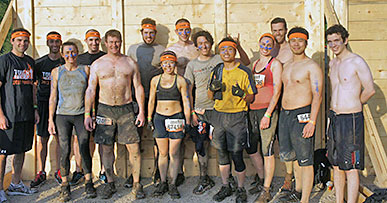
|
| |

8. Seniors lauded at recognition dinner
In a long-standing Aeronautics and Astronautics Department tradition, members of the graduating senior class were presented with a bevy of awards at the 2013 Senior Recognition Dinner.
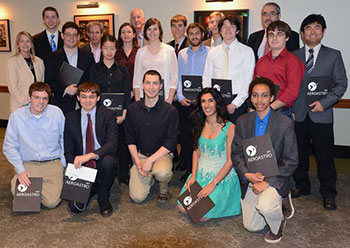
Awards and recipients were:
Lockheed Martin Prize for Excellence in Systems Engineering Teamwork. The DBF Team: Ivan Amador, Rebecca B. Colby, Casey L. Denham, Elizabeth A. Jones, Gregory D. Kravit, Giulia B. Pantalone, Samuel L. Range, Daniel J. Rankin, Margaret J. Reagan, Joseph M. Salinas, Jedediah Storey, Arshia S. Surti, Tony Tao, Joseph Marcel R. Williams for exemplary teamwork and creativity in the development and execution of a non-conventional design for the AIAA Design, Build, Fly Competition.
Rene H. Miller Prize for Excellence in Systems Engineering Alexander Buck and Austin Nicholas for developing an innovative new architecture for lean, affordable lunar exploration.
Apollo Program Prize Edward (Eddie) Obropta for successful development of textile modeling and shape memory alloy testing and quantification for advanced mechanical counter pressure spacesuits.
United Technologies Corp. Prize Peter Florin and James Byron for innovative wind-tunnel experiments demonstrating an increase in power from ducted wind turbines via trailing-edge devices.
Leaders for Manufacturing Undergraduate Prize Andras Kiss and Jay Pothula for manufacture and assembly of a complex wind-tunnel cascade assembly used to demonstrate and visualize the occurrence of spike-stall found in compressors.
Thomas B. Sheridan Award Elizabeth d’Arienzo and James Wiken for ingenuity shown in assessment of human interaction, via gesture control techniques, as applied to bomb disposal robots.
Admiral Luis De Florez Prize Samuel Range for demonstrated ingenuity in the development and manufacturing of a small deployable UAV.
James Means Award for Excellence in Flight Vehicle Engineering Elizabeth (Libby) Jones for excellence and leadership in the construction and demonstration of a flexible UAV production system.
James Means Award for Excellence in Space Systems Engineering Leonard Tampkins for dedication and perseverance in working as the avionics and communications lead on the TERSat project, including successful demonstrations at the Flight Competition Review. Brian Coffee for excellence in working with the MicroMAS attitude determination and control team, in particular on contributions to nanosatellite geolocation.
AeroAstro Undergraduate Teaching Assistantship Award Brian Coffee and James Wiken for effective execution and consistent dedication to the advancement of undergraduate learning and performance in 16.07-Dynamics.
The AeroAstro Graduate Teaching Assistantship Award Farah Alibay for her outstanding work as 16.83 TA, especially in helping to implement Concurrent Design Facility software into the class structure. Tony Tao for outstanding educational commitment and technical excellence in the 16.82x Flight Vehicle Design and Development subject.
The Henry Webb Salisbury Award Harriet Li for superior and multiple-dimensional academic achievements in the undergraduate program. Andras Kiss for superior and multiple-dimensional academic achievements in the undergraduate program.
|
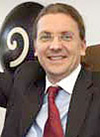 Spakovszky Spakovszky
|

9. Welcome
Welcome to new postdoc Neil Titchener who will be working with Professor Ed Greitzer in the Gas Turbine Lab.
Professor Zolti Spakovszky and his wife, Wiebke, welcomed their baby boy, Felix, early on June 19. Best wishes, and congratulations to Zolti and Wiebke, and big brother Simon. |
 
|

Follow AeroAstro
Don't wait for your enews and emails — keep up with AeroAstro news as it happens — follow the department on Twitter and Facebook. |
|
If you know of events, honors, activities, or other information you'd like to see in the next issue of AeroAstro enews, please send to wlitant@mit.edu — we'd be pleased to include your submissions. |
|
|


 Tweddle
Tweddle Leveson
Leveson Modiano
Modiano Williams
Williams Hastings
Hastings Young
Young


 The team's plane, "Li'l Nugget" now hangs in the Neumann Hangar
The team's plane, "Li'l Nugget" now hangs in the Neumann Hangar


 Spakovszky
Spakovszky